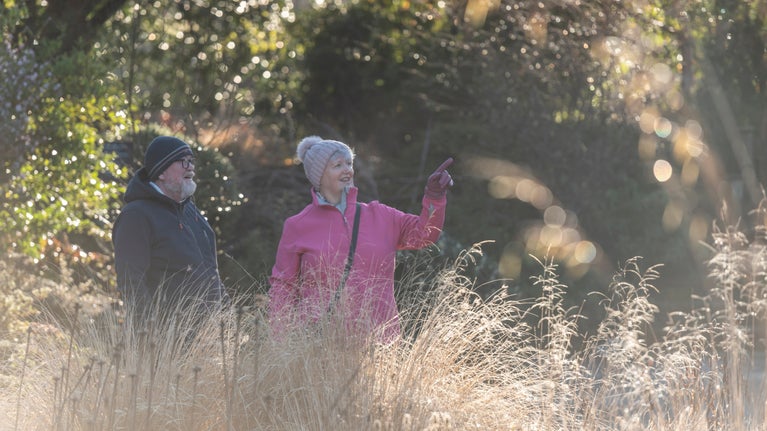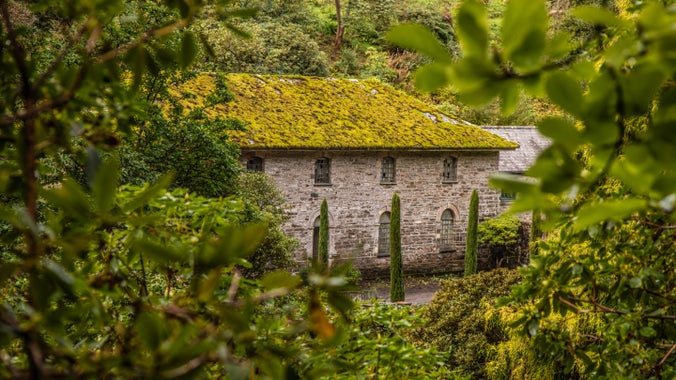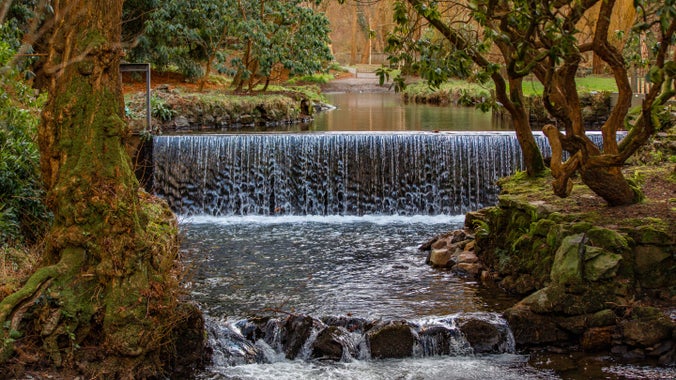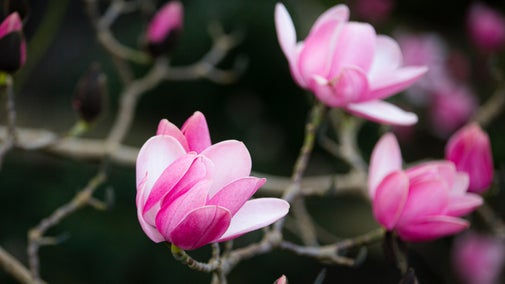
Discover more at Bodnant Garden
Find out when Bodnant Garden is open, how to get here, the things to see and do and more.

A great garden offers something to enjoy during every season and Grade I listed Bodnant has 80 acres of formal gardens, woodland and panoramic mountain views to stir your senses. Find a walk that's suitable for you, and admire the beauty of the colourful planting schemes.
The Winter Garden is the jewel in Bodnant's crown. Once a neglected Edwardian rockery, the area was renovated and opened to the public in 2012. It has since matured into a sensational display of foliage, flower, bark and scent.
The garden makes the most of the winter light, which at midday shines from the south across the Old Park, backlighting the plants. This is also the perfect time to admire the garden's strong evergreen structure, particularly in the Dell.
Mature trees give structure to the planting scheme, as do many shrubs such as rhododendrons, garrya, camellia and the stunningly gnarled old Acer palmatum.
Beneath this is a layer of small shrubs and herbaceous plants include red leaved bergenia and pittosporum, arching grasses and ferns, heathers and hellebores, with a colourful underplanting of bulbs such as snowdrops, iris, cyclamen and crocus.
The first blooms to appear at Bodnant are the unusual specimens, which begin to pop up their heads in the Winter Garden in January (sometimes earlier). They're followed by a mass display of common snowdrops in the Old Park meadow. The Old Park is one of the oldest parts of the garden, dating back to the Georgian era, and we’ve been planting snowdrops there in recent years as part of an annual tradition to keep growing the display into the future.

Located in the upper garden, the Winter Garden is flat, level and accessible. Why not follow the Winter Garden trail? For a longer winter wander, follow the streamside paths down to the Dell. From here you can continue upstream underneath the canopy of towering evergreen trees to the beautiful lakeside at the Far End.
The Furnace Wood and Meadow trail will take you to new heights and reward you with panoramic views, while the 1.5km-long rose walk takes in the formal garden with expansive views across the valley and down to the river.
Meanwhile, the river walk (3km) will take you alongside the river, Hiraethlyn, and through the arboretum. This route includes some slopes but avoids steps.
Some paths may be closed off if icy or slippery but, whether you want a brisk breath of fresh air or a leisurely stroll, you’ll find peace and inspiration among Bodnant's 80 acres.
The Winter Garden provides an oasis for wildlife too. The presence of flowers all year round helps pollinators throughout the seasons and seedheads provide food for a variety of wildlife too.
Plants with berries, such as Skimmia Japonica, will feed hungry birds. See how many different species of birds you can spot making use of the many bird boxes and feeders around the garden.

During autumn 2024, Bodnant Garden celebrated 150 years since it was bought at auction by Victorian industrialist Henry Davis Pochin and his wife, Agnes. At the time, Bodnod as it was then known, was an estate with a walled garden, woods and plantations. It was Pochin's grand vision which shaped and led to the Grade 1 listed garden that we see today.
2024 also marked 75 years since Bodnant Garden was gifted to the National Trust by Henry McLaren, Lord Aberconway. In 1948 he persuaded the National Trust to accept gardens on their own merit into the fold of the charity, Bodnant being only the second admitted in 1949, after Hidcote.
Cared for by the National Trust since 1949, Bodnant is a garden of firsts. Home to the earliest and grandest laburnum arch completed in around 1880, and to some of Britain’s earliest magnolias introduced from China in the late 1800s. It’s said there's a rhododendron in bloom every month of the year here, but they reach a peak in April and May.
The garden is especially famous for its Asian rhododendrons, including unique hybrids bred at the garden from the 1920s. Many of these unique varieties can still be seen in the garden today. Bodnant Garden is also home to five National Collections – Rhododendron forrestii, magnolias, embothriums (Chilean fire bush), eucryphias and Bodnant Hybrid rhododendrons.
Bodnant Garden is famed as the finest rose garden in Wales with its five formal Italianate terraces, designed and built in the new Arts and Crafts style between 1904 and 1914. Home to many established varieties of roses, including many of the David Austin varieties, it comes alive with colour and perfume from June until late September.
Two of the terraces are recognised for their picturesque ponds, which are home to water lilies and a variety of wildlife. The borders on each of the terraces are planted with careful consideration of the surrounding environment and are in keeping with the year of their creation. Each of the five terraces was intended to be a revelation as you descend to the next.
A fountain located on the Croquet terrace at Bodnant Garden is believed to have been created by French sculptor Edmé Bouchardon in around 1700. Today, the fountain’s elaborate oolitic limestone designs have been worn away by decades of running water. You can help us to raise funds to create a new fountain, bringing this area of the five Italianate terraces back to life. Find out more about the appeal and how to donate here.
The golden blooms of the Laburnum Arch attract thousands of visitors to the garden in late May and early June each year. The arch flowers for between 10 to 14 days each year. The arch is the only one of its kind in the country which is curved, following the wall which runs alongside.
The Round Garden, with its 18th century water fountain, provides interest through the spring and summer with its four quadrants and new planting scheme. Structural forms and seed heads offer interest through the autumn and winter months.
The Winter Garden, located just before the top gate to the Old Park Meadow, is a maze of pathways that take you through a variety of cornus, skimmia, cyclamen, iris and daphne. Coming alive in the winter months as its name suggests, it provides interest and a tranquil spot to sit.
Providing the first hints of the surprises that await down in The Dell, the Shrub Borders are home to camellias and tree magnolias and some of the famous blood-red Bodnant hybrid rhododendrons. Behind the Pin Mill, a path leads down, past banks of camellias and rhododendrons to a stream-fed rockery that comes alive with giant Himalayan lilies, ferns and hostas in late spring and early summer.
Separating the Shrub Borders and the Dell, the Glades are a good area for daffodils in the spring, and the bluebells that follow hot on their heels. Fiery shades of red and amber burst through during the autumn months. Trees from all over the world, including cornus, prunus, liquidambar and paulownia provide year-long interest with the acers lighting up the arboretum from September to November.

The rich soil and moist atmosphere of the Dell suit the larger-leaved rhododendrons. Discover the Waterfall Bridge, with its vertical torrent of water on one side, and the calm, reflective pool on the other. Home to wildlife including kingfishers, dippers, heron and ducks. Further upstream you’ll find the Skating Pond and Boathouse, with weeping willows, swamp cypress and azaleas that signal the start of spring with vibrant colours.
This area of the garden offers fine views back towards the house and terraces as well as across to the Conwy River. Penjerrick Walk, along the top of Furnace Hill, comes alive in spring with a variety of rhododendron which include amongst others Augustinii, Penjerrick and ‘Reve d’amour’. Discover Lady Anglesey’s Seat and sit for a while to enjoy the view across to the house and terraces.
Bodnant Garden has two wildflower meadows. The Old Park Meadow dates to the Georgian era and is now home to daffodils in early spring with wildflowers as far as the eye can see appearing throughout May and June. During winter, sheep graze in the Old Park up to Christmas. Furnace Meadow lies on the southern hillside, overlooking the riverside garden and is a peaceful spot to take a moment to enjoy nature, no matter the season.

Find out when Bodnant Garden is open, how to get here, the things to see and do and more.
Enjoy delicious refreshments at Bodnant Garden’s tea-rooms all year round or from the riverside kiosk down in The Dell.

With 80 acres to explore, there's a walk to suit everyone. From 1 October to the end of March 2026, dogs are welcome every day on short leads (not extendable). Find out more about bringing your dog to Bodnant Garden here.

Explore the many exotic and rare plants and trees at Bodnant Garden, including five National Collections, as well as Wales’s largest collection of UK Champion Trees.

Discover how a 'dwelling by a stream' in Snowdonia's foothills grew into a global horticultural haven thanks to generations of the McLaren family and Puddle head gardeners.

The garden at Bodnant is the work of generations, starting with the Pochin family and their move from Manchester. Learn about the people who made Bodnant into what we see today.
